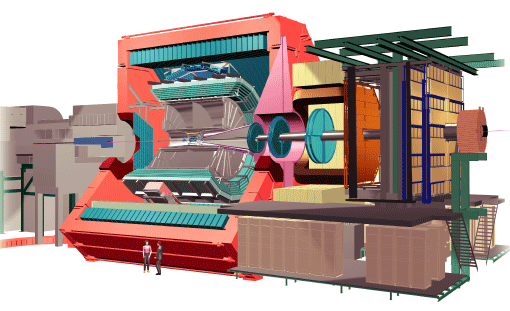
First, one needs to know the initial conditions, namely how powerful the collision was: this is done by measuring the remnants of the colliding nuclei in detectors made of high density materials, located about 110 meters on both sides of ALICE (the ZDCs), and by measuring the number of particles produced in the collision and their spatial distribution with the FMD, V0, and T0. T0 also measures the time when the event took place with high precision. The position where particles originate is also important – if one appears deep within the detector, it is likely to have been produced by the decay of another particle produced earlier, possibly within the collision itself.
Tracking particles
An ensemble of cylindrical detectors (from inside out: ITS, TPC, TRD) measures the passage of each particle carrying an electric charge at many points, so that its trajectory is precisely known. The ALICE tracking detectors sit within a magnetic field, produced by a huge red solenoid magnet, bending the trajectories of the particles; from the particles' curvature we can find their momentum. The ITS is so precise that particles generated by the decay of other particles with a very short life time can be identified by seeing that they do not originate from the point where the interaction has taken place (the “primary vertex” of the event) but rather from a point at a distance of as small as a tenth of a millimeter.
The particles' identity
In addition to the information given by ITS and TPC, more specialized detectors are necessary to reveal the particle's identity. The TOF measures, with precision greater than a tenth of a billionth of a second, the time that each particle needs to travel from the vertex to reach it, so that its speed can be measured. The HMPID measures the faint light patterns generated by fast particles and the TRD measures the special radiation emitted by very fast particles when they cross different materials, thus allowing the identification of electrons. Muons are measured by exploiting the fact that they penetrate matter easier than most other particles. In the forward region, a very thick and complex absorber stops all other particles and muons are measured by a dedicated set of detectors: the muon spectrometer. The muon spectrometer features an additional muon filter comprising a 1.2 m-thick iron wall.
Catching Photons
To measure photons special detectors are necessary: the crystals of the PHOS, which are as dense as lead and as transparent as glass, measure them with fantastic precision in a limited region, while the PMD and in particular the EMCal measures them over a very wide area. The EMCal also measures groups of close particles (called “jets”), which have a memory of the early phases of the collision.
